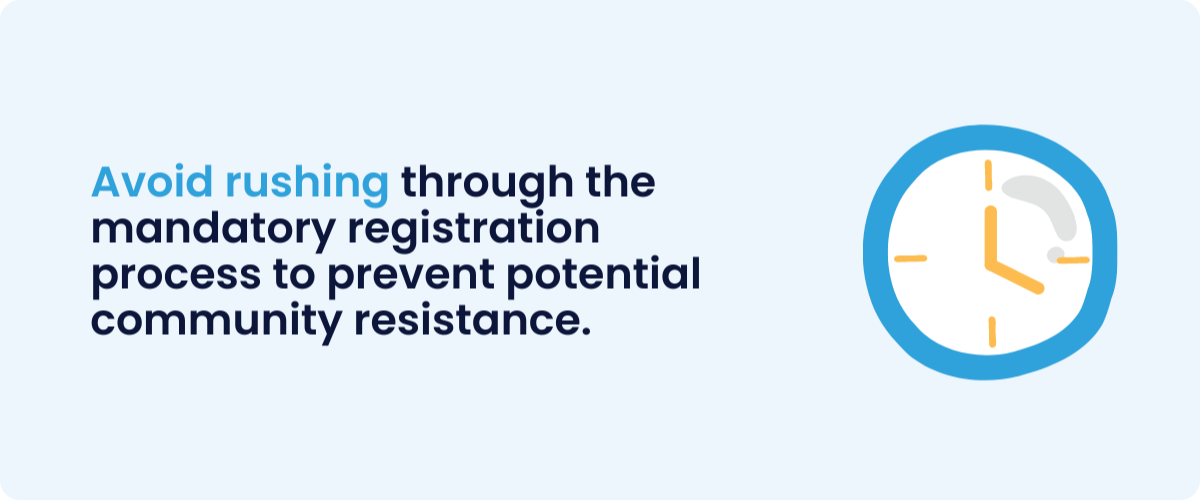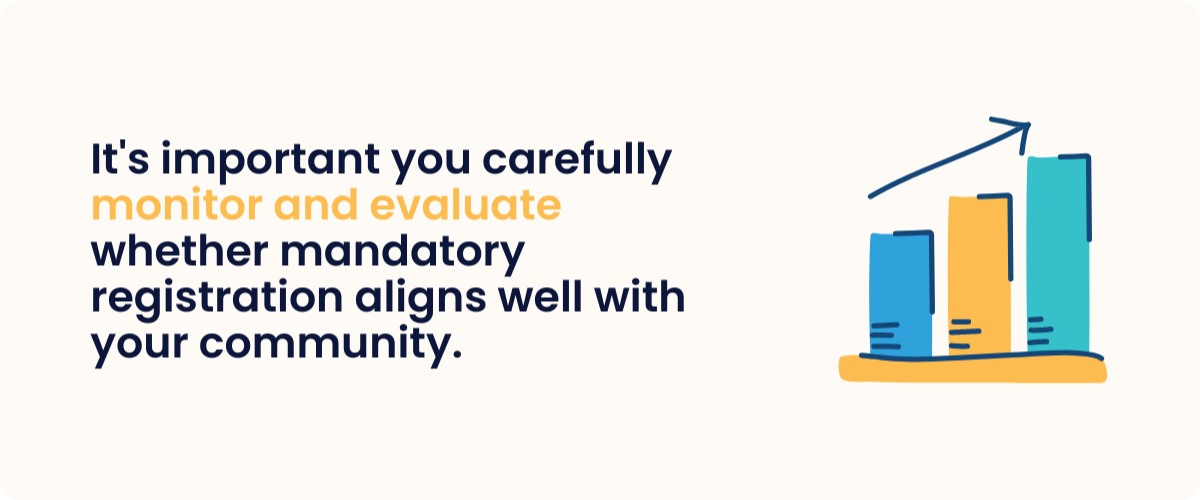When it comes to collecting authentic and high-quality data, mandatory registration for your community engagement site can prove to be a valuable tool. With the implementation of mandatory registration, organizations can enhance their decision-making and community engagement efforts by ensuring that feedback is received from genuine individuals who are true residents of the area.
The mandatory registration process requires individuals to provide their personal details before participating in community activities. The data collected then enables organizations to consistently improve and tailor their engagement initiatives, therefore creating more relevant experiences that better cater to the specific needs of the community.
While mandatory registration may encounter certain barriers, such as community resistance and concerns about data collection, it is essential to prioritize transparency and openness throughout this process. By building trust within the community, and remaining honest about how data is collected and stored.
In this article, we will explore the benefits of using mandatory registration and provide recommendations on how to effectively implement this useful tactic on your community engagement site.
What are the benefits of mandatory registration for community engagement?
While open, public projects are great for community engagement and getting everyone involved, they can also come with their own challenges.
As these projects are available for anyone and everyone to get involved and have their say, it’s almost impossible to track unique instances of feedback or understand the demographic breakdown of responses. Data can be distorted and skewed, especially if certain stakeholder groups are actively dominating the conversation.
Because of this, these open projects sometimes have the ability to sway certain outcomes in a different direction compared to ideal participants and their preferences.
Even though you are receiving a large amount of feedback, these individuals may not actually be representative of your community of interest. This is where mandatory registration comes in.
By encouraging people to register on your community engagement site, you can remain confident that the feedback you are receiving is not only genuine but is coming from stakeholders that have a vested interest in the project.
With mandatory registration, you also gain access to more accurate and valuable insights, such as demographic data, to better understand your community’s needs and concerns. This valuable data empowers you to tailor your engagement strategies to ensure you are truly reaching a representative cross-section of your community and effectively target the right audience.
Mandatory registration allows organizations to maintain a database of community members, enabling you to establish stronger connections, gather feedback, and provide personalized support. It can also be used to facilitate effective communication, as registered participants can be notified about upcoming events, updates, or opportunities for involvement.
And, as you consistently capture unique data from community members, you can further understand and identify where you may see gaps in representation and reach – allowing you to pivot your strategy when needed.
How can you implement mandatory registration for community engagement?
If you are considering implementing the use of mandatory registration for your community engagement initiatives, let’s explore the recommended steps to help you get started.

1. Gradually implement mandatory registration.
Whilst change can be new and exciting, your community may be confused or concerned about the shift.
If you were to suddenly implement mandatory registration, you may encounter resistance from your community. Folks may have questions about the purpose of data collection or the need for providing personal information. People can be very cautious about their personal data and privacy, especially among older generations.
If you’re looking to implement mandatory registration, we’ve had a few clients trial this technique on specific projects or different participation tools – just so they can understand the impact this may have on feedback.
It is also important to be open and transparent with the public about your intentions, by providing information and addressing any concerns or questions you can ensure everyone is on the same page.

2. Inform your community through various communication channels
Okay, so you’ve conducted a trial with your community, and you’re ready to implement mandatory registration across your entire engagement site. What’s next?
To prepare your community and ensure they are well-informed about this change, early communication is key. But what is the most effective approach?
We recommend using a mix of information and visuals to explain the change. Visuals can be highly effective in conveying information as they are often easier to understand compared to plain text. Videos, in particular, provide a powerful tool to explain the process and highlight the benefits.
It is also vital to select the appropriate platforms to reach your community effectively. Review where your community connects with you most and consider utilizing multiple channels to maximize your reach and engagement.
Let’s delve deeper and review which channels you can utilize to inform your community regarding mandatory registration.
Email marketing campaigns.
By evaluating your existing membership base, you can work towards developing an email marketing campaign to inform your community of this change. The primary objective of this campaign will be to ensure that your clients are well-informed about the change, including its purpose, benefits, and any necessary actions they need to take prior to the implementation date.
This personalized approach will help foster engagement, maintain transparency, and enhance the overall user experience throughout this transitional phase.
Social media promotions.
It is likely that some individuals may have previously opted out of receiving emails, while others may not have received them simply because they haven’t subscribed to your email campaigns. Therefore, it’s crucial to ensure that these individuals are still informed about the change. One effective alternative for reaching out to your community is through your social media channels.
Social media serves as an excellent platform to keep people updated and also offers an opportunity to expand your membership base. This can be accomplished either through organic reach or through paid advertising campaigns.
Website articles and FAQs.
Your organization’s website (or current engagement site) serves as a centralized hub of information, allowing anyone who visits the site to easily stay informed about changes and recent developments. By featuring this important update on the homepage, you ensure maximum visibility and accessibility for a wide range of users.
This also presents an opportunity to direct users to an article, video, or frequently asked questions (FAQ) section, offering more detailed information to address any potential confusion.

3. Implementing and evaluating your mandatory registration process.
Once you have informed your community, it is now time to implement mandatory registration (you made it!).
Throughout this implementation period, you may get some more confusion or pushback, but it’s important to be patient with your community and provide more support to ensure folks feel safe and informed.
At the end of the day, this will save your community loads of time as they won’t have to consistently enter demographic information. And, people will only receive the most relevant updates and notifications that align with their interests.
Once implemented, it’s also important you carefully monitor and evaluate whether mandatory registration aligns well with your community. Have you achieved your intended objectives? This includes gathering feedback from a wide variety of tools and analyzing the quality of feedback you’ve collected.
By assessing the quality of feedback and overall satisfaction of participants, you can easily pinpoint any challenges or barriers faced by your community and identify areas for improvement.
Is your feedback more representative of your intended audience? Are you identifying greater gaps in your engagement strategy and targeting? Do you need to focus more on specific age groups? Are locals in certain areas not engaging?
Implementing mandatory registration gradually enables the collection of higher-quality feedback and promotes authentic engagement within the community. By addressing concerns and maintaining transparency regarding data collection and usage, you can effectively mitigate fear and resistance among community members.
Additionally, leveraging a variety of communication channels such as email marketing campaigns, social media platforms, and your organization’s website ensures widespread visibility and accessibility. This approach guarantees that all community members stay well-informed about updates and changes, fostering a sense of unity and shared understanding.












